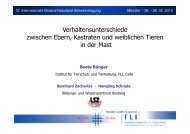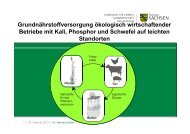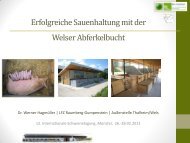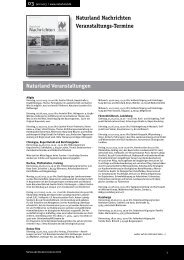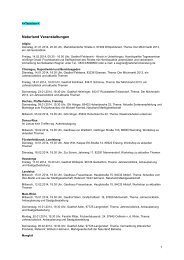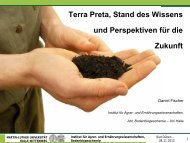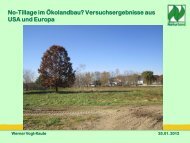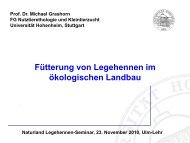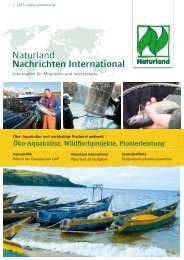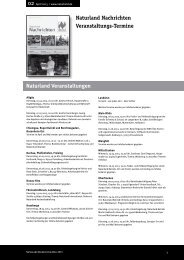Organic Farming in the Tropics and Subtropics: Peanuts - Naturland
Organic Farming in the Tropics and Subtropics: Peanuts - Naturland
Organic Farming in the Tropics and Subtropics: Peanuts - Naturland
You also want an ePaper? Increase the reach of your titles
YUMPU automatically turns print PDFs into web optimized ePapers that Google loves.
II Special section: <strong>Organic</strong> Peanut Cultivation<br />
3.1. The aflatox<strong>in</strong> problem<br />
<strong>Peanuts</strong> are extremely susceptible to <strong>in</strong>fection by <strong>the</strong> fungi Aspergillus flavus. All<br />
cultivation measures should be well-planned, to take this aspect <strong>in</strong>to consideration.<br />
Aflatox<strong>in</strong> <strong>in</strong> food can affect <strong>the</strong> health of both man <strong>and</strong> animal. The poison aflatox<strong>in</strong><br />
is created by fungi of <strong>the</strong> species Aspergillus flavus <strong>and</strong> Aspergillus parasiticus,<br />
which are widely dissem<strong>in</strong>ated <strong>in</strong> tropical <strong>and</strong> subtropical soils. Import<strong>in</strong>g countries<br />
have set maximum tolerance values for <strong>the</strong> presence of aflatox<strong>in</strong> <strong>in</strong> foodstuffs, <strong>in</strong><br />
order to protect consumers. For consumers <strong>in</strong> <strong>the</strong> produc<strong>in</strong>g countries, <strong>the</strong> risks due<br />
to <strong>the</strong> poison are more difficult to ascerta<strong>in</strong>, because <strong>the</strong> larger part of <strong>the</strong> peanut<br />
harvest is consumed or sold on local markets. Thereby, <strong>the</strong>re are also no “dilution”<br />
effects caused by large quantities, mean<strong>in</strong>g that both humans <strong>and</strong> animals can be<br />
subjected to high doses of aflatox<strong>in</strong>. Additionally, malnutrition leads to immune<br />
systems be<strong>in</strong>g weakened. In addition to <strong>the</strong> huge health risks <strong>in</strong>volved, it also<br />
stimulates <strong>the</strong> growth of a whole row of chronic diseases, first <strong>and</strong> foremost of which<br />
is cancer of <strong>the</strong> liver. By heed<strong>in</strong>g <strong>the</strong> preventative measures outl<strong>in</strong>ed, economic or<br />
health problems regard<strong>in</strong>g an aflatox<strong>in</strong> <strong>in</strong>fection should not even arise.<br />
Infection before <strong>the</strong> harvest<br />
The fungi penetrates <strong>the</strong> pods dur<strong>in</strong>g <strong>the</strong>ir growth period whilst still <strong>in</strong> <strong>the</strong> soil, this<br />
takes place <strong>in</strong> two ways:<br />
A) Infection through <strong>in</strong>visible damage to <strong>the</strong> pods or seeds:<br />
Mechanically damaged or bitten pods will quickly be <strong>in</strong>fected by <strong>the</strong> fungi, which<br />
feeds primarily on dead <strong>and</strong> dy<strong>in</strong>g tissue.<br />
Hot, dry soil conditions abets attacks by termites, which are vectors for <strong>the</strong> fungi’s<br />
spores.<br />
Alternat<strong>in</strong>g phases of ra<strong>in</strong> <strong>and</strong> drought causes <strong>the</strong> pods to split open, <strong>and</strong> produc<strong>in</strong>g<br />
high aflatox<strong>in</strong> values <strong>in</strong> <strong>the</strong> seeds.<br />
B) Invisible <strong>in</strong>fections of <strong>the</strong> pods:<br />
Many pods are <strong>in</strong>fected after <strong>the</strong> pegs have been pushed down <strong>in</strong>to <strong>the</strong> soil. Yet<br />
when <strong>the</strong> plant enjoys good grow<strong>in</strong>g conditions, <strong>the</strong> fungi may rema<strong>in</strong> <strong>in</strong>active <strong>and</strong><br />
no significant amounts of aflatox<strong>in</strong> are produced; this is because peanut plants<br />
have a natural protection mechanism: The grow<strong>in</strong>g plant produces immune<br />
substances (phytoalex<strong>in</strong>), which have a anti-microbe <strong>and</strong> fungus-suppress<strong>in</strong>g effect<br />
(arachid<strong>in</strong>). All cultivation measures that encourage healthy, natural growth <strong>in</strong> effect<br />
support this protection mechanism.<br />
The production of phytoalex<strong>in</strong>s s<strong>in</strong>ks towards maturity, as well as due to water<br />
deficiency, <strong>and</strong> ceases altoge<strong>the</strong>r if a drought cont<strong>in</strong>ues. In contrast, <strong>the</strong> fungi A.<br />
flavus is still able to proliferate <strong>and</strong> create aflatox<strong>in</strong> at much dry conditions, before it<br />
also f<strong>in</strong>ally ceases all activity. It is encouraged at average temperatures of 26-30°C<br />
<strong>in</strong> <strong>the</strong> upper 5 cm of <strong>the</strong> soil. In dry periods, <strong>the</strong> peanut plant folds its leaves<br />
toge<strong>the</strong>r, mean<strong>in</strong>g that <strong>the</strong> ground receives even less shade, so that soil<br />
temperatures rapidly <strong>in</strong>crease. In hot, dry conditions, A. flavus grows very rapidly,<br />
Naturl<strong>and</strong> e.V. – 1 st edition 2000 page 15



